Knowde Enhanced TDS
Identification & Functionality
- Active Component
- Ingredient Origin
- Ingredients
- Fenugreek, Artichoke, Caihua
Features & Benefits
- Benefit Claims (Health)
- Labeling Claims
- Product Highlights
Since liver is the most important organ involved in lipid metabolism. It is essential to preserve and improve its functions. Omeolipid has strong hepatoprotective and antioxidant effects thanks to artichoke as well as depurative effect (artichoke and caihua Moreover, Omeolipid promotes bile production and flow essential for cholesterol clearance. in addition fenu greek decreases gut absorption of cholesterol therefore its uptake.
Omeolipid® is also able to counteract the adverse effects commonly associated with obesity and high level of cholesterol
- Altered carbohydrates metabolism: caihua and fenu greek improve glycemic level control, as they are hypoglycemic agents
- Kidney dysfunction caihua improves diuresis.
- Hypertension caihua helps regulating blood pressure.
Omeolipid is the right choice for a more complete and holistic approach to lipid balance and well-being.
Applications & Uses
- Markets
- Food & Nutrition Applications
- Physiologic and Healthcare Applications
- Hypolipidemic.
- Anti-cholesterolemic.
- Hypoglycemic.
- Improves liver functions.
- Depurative and diuretic.
- Improves blood pressure.
- Antioxidant.
- Omeolipid Combinations
ARTICHOKE Cynara scolymus L
Artichoke is a Mediterranean plant its cultivation in Europe dates back to ancient Greece and Rome. Its active substances (cafeoylquinic acids lavonoids, sesquiterpene lactones) are concentrated in the leaf, acting as digestive, colagougue, hepatoprotective and depurative.
CAIHUA Cyclanthera pedata (L) Schrad
Caihua is a traditional plant from South America the fruit contains flavanoids
and in Peru. Its use is documented since 3700 b.C as impotence antidiabetic, anti intammatory and hypocholesteroiemic.FENU GREEK Trigonella foenum-graecumL
Fenu greesamlestone of the Ayurvedic medicine, alleviating kapha and vata.
The seeds contain saponines. coumarines, flavonoids and alkaloids. They are
traditionely used to treat obesity and diabeties, having hypocholesterolemic.
diuretic, dophoretic, carminative. hypoglycemic and demulcent properties
Properties
- Odor
- Characteristic
- Taste
- Characteristic
- Partially Soluble in
- Water
- Typical Properties
- Microbiological Values
- Nutritional Information
- Heavy Metals
| Value | Units | Test Method / Conditions | |
| Particle Size (through 300 microns) | 90 | % | — |
| Bulk Density | 450 - 750 | g/L | — |
| Loss on Drying | max. 7.0 | %w/w | — |
| pH | 4 - 6 | — | — |
| Heavy Metals | max. 20 | ppm | (method C Ph. Eur. current edition) |
| Aflatoxin B1 | max. 2 | ppb | — |
| Aflatoxin B1,B2,G1,G2 | max. 4 | ppb | — |
| Benzo(a)pyrene | max. 10 | ppb | — |
| Sum of Benzo(a)pyrene, benzo(a)anthracene, benzo(b)fluoranthene and chrysene | max. 50 | ppb | — |
| Pyrrolizidine Alkaloids | max. 400 | ppb | — |
| Bile-tolerant gram-negative bacteria | max. 100 | ufc/g | — |
| Value | Units | Test Method / Conditions | |
| Bacterial Count | max. 50000 | ufc/g | (TAMC: ref. 5.1.8, cat. B oral use): |
| Yeasts and Moulds Count | max. 500 | ufc/g | (TYMC: ref. 5.1.8, cat. B oral use): |
| Value | Units | Test Method / Conditions | |
| Carbohydrates | 90 - 95 | % | — |
| Fat Content | 0 - 1 | % | — |
| Protein Content | 0 | % | — |
| Energy Value | 405 | Kcal/100 gr | — |
| Value | Units | Test Method / Conditions | |
| Minerals | 5 - 7 | % | — |
| Lead Content | max. 3 | ppm | (ref. Reg. (EC) 1881/2006) |
| Cadmium Content | max. 1 | ppm | (ref. Reg. (EC) 1881/2006) |
| Mercury Content | max. 0.1 | ppm | (ref. Reg. (EC) 1881/2006) |
Regulatory & Compliance
- Certifications & Compliance
- Certifications
- DNA CERTIFIED RAW MATERIALS
- GMO: Free from GMO (Reg. (EC) 1829/2003 and 1830/2003)
- BSE/TSE FREE - GLUTEN FREE
- ALLERGENS: Free from substances or products causing allergies or intolerances (Reg. (EU) 1169/2011 Annex II)
Technical Details & Test Data
- Comparative Test Result
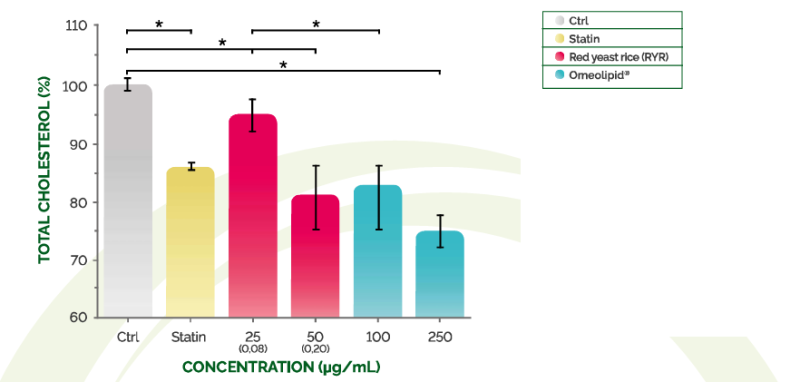
Omeolipid decreased the percentage of total cholesterol compared to the three single
plants. RYR and Ctri cells, There were no significant differences between stain and Omeolipid® activity.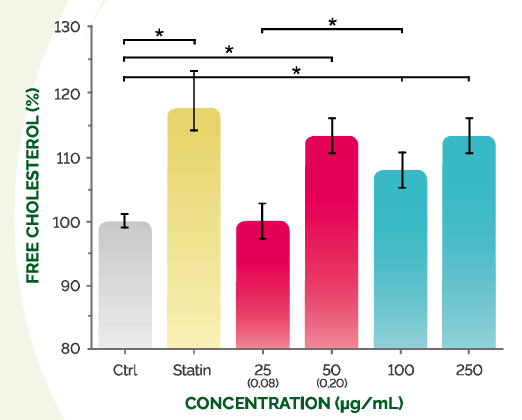
Omeolipid increased the percentage of free cholesterol compared to cells tested with RYR and Ctrl cells.
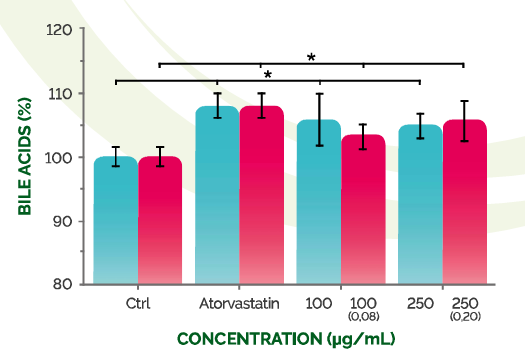
Omeolipid® RYR and synthetic statin increased the percentage of bile produced by hepatocytes compared to Ctrl cells.
- Test Data
The anti-cholesterolemic and cholagogue activities of Omeolipid® were evaluated on human in vitro liver model (HEPG2 cell line). Total cholesterol is made of two fractions: esterified for cholesterol transport in blood (HDL, LDL etc.) and free or not esterifed for its elimination via bile.
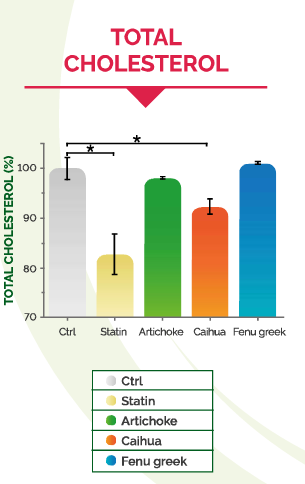
Caihus decreases total Cholesterol of about 10% vs non-treated cells.
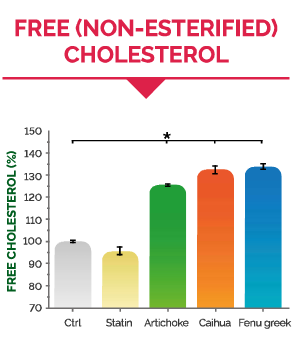
Artichoke. Caihua and Fenu greok increase free cholesterol of about 25-30 vs Ctrl allowing an increase of cholesterol clearance Statin does not increase free cholesterol fractions
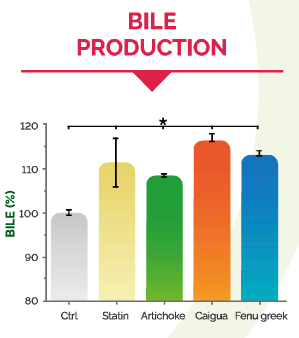
Artichoke. Caihua and Feru greek increase the production of bile of about 10-20% promoting cholesterol clearance and liver functionality. Stain weekly affects bile production.
Storage & Handling
- Shelf Life
- 3 Years
- Storage
Store in a well closed container away from moisture and direct sun light.

